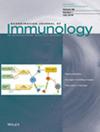血液防御系统--关于由肝、脾和骨髓组成的血液传播病原体免疫系统新概念的建议
IF 1.6
4区 医学
Q2 IMMUNOLOGY
引用次数: 0
摘要
血源性病原体(BBP)感染可迅速发展为危及生命的败血症,因此必须由宿主的免疫系统及时清除。肝窦、脾边缘区和红髓的血管内巨噬细胞以及骨髓(BM)窦周的巨噬细胞突起直接吞噬血液中的 BBP,这是一种先天性免疫反应。因此,肝脏、脾脏和骨髓作为血液防御系统(BDS),通过发挥各自不同的免疫作用,共同应对 BBPs。肝脏通过先天性免疫清除这些入侵生物的绝大部分,但如果没有抗体的作用,就不可能完全清除它们。脾边缘区 B 细胞会迅速产生针对 BBPs 的 IgM 和 IgG 抗体。脾边缘区将抗原信息从先天性免疫系统传递到适应性免疫系统。脾脏白髓作为适应性免疫组织,产生特异性和高亲和性抗体,对 BBPs 具有免疫记忆。基础细胞膜通过支持记忆 B 细胞、记忆 T 细胞和长寿命浆细胞(LLPCs)的存活来维持免疫记忆,所有这些细胞都有专门的龛位。此外,BM 窦状体周围的幼稚滤泡 B 细胞会迅速产生针对 BBPs 的 IgM 抗体,驻留在 BM 中的 IgG 记忆 B 细胞会迅速转化为浆细胞,在再次感染时产生高亲和性 IgG 抗体。本综述描述了 BDS 通过肝脏、脾脏和 BM 的协作,结合不同的免疫学作用,对 BBPs 的完整免疫防御特征。本文章由计算机程序翻译,如有差异,请以英文原文为准。
Blood defense system – Proposal for a new concept of an immune system against blood borne pathogens comprising the liver, spleen and bone marrow
Blood‐borne pathogen (BBP) infections can rapidly progress to life‐threatening sepsis and must therefore be promptly eliminated by the host's immune system. Intravascular macrophages of the liver sinusoid, splenic marginal zone and red pulp and perisinusoidal macrophage protrusions in the bone marrow (BM) directly phagocytose BBPs in the blood as an innate immune response. The liver, spleen and BM thereby work together as the blood defence system (BDS) in response to BBPs by exerting their different immunological roles. The liver removes the vast majority of these invading organisms via innate immunity, but their complete elimination is not possible without the actions of antibodies. Splenic marginal zone B cells promptly produce IgM and IgG antibodies against BBPs. The splenic marginal zone transports antigenic information from the innate to the adaptive immune systems. The white pulp of the spleen functions as adaptive immune tissue and produces specific and high‐affinity antibodies with an immune memory against BBPs. The BM works to maintain immune memory by supporting the survival of memory B cells, memory T cells and long‐lived plasma cells (LLPCs), all of which have dedicated niches. Furthermore, BM perisinusoidal naïve follicular B cells promptly produce IgM antibodies against BBPs in the BM sinusoid and the IgG memory B cells residing in the BM rapidly transform to plasma cells which produce high‐affinity IgG antibodies upon reinfection. This review describes the complete immune defence characteristics of the BDS against BBPs through the collaboration of the liver, spleen and BM with combined different immunological roles.
求助全文
通过发布文献求助,成功后即可免费获取论文全文。
去求助
来源期刊
CiteScore
7.70
自引率
5.40%
发文量
109
审稿时长
1 months
期刊介绍:
This peer-reviewed international journal publishes original articles and reviews on all aspects of basic, translational and clinical immunology. The journal aims to provide high quality service to authors, and high quality articles for readers.
The journal accepts for publication material from investigators all over the world, which makes a significant contribution to basic, translational and clinical immunology.

 求助内容:
求助内容: 应助结果提醒方式:
应助结果提醒方式:


